What’s New and Exciting in AI for Drupal: Latest Innovations and Trends
AI — one of the most breathtaking inventions of the 21st century — isn’t just changing the game; it’s rewriting the rulebook for effective website management and creation. The Drupal community knows this well, which is why embracing AI has become a top priority for the platform.
We were all glued to Dries’ presentation as AI renamed content types, generated alt text for images, migrated content from non-Drupal sites, turned hand-drawn sketches into fully functioning online forms, and more. Exploring the AI Interpolator module, we were amazed by videos of people speaking in rhyme and entire image galleries generated on the fly for articles. These are just a few examples, but they speak volumes about how rapidly AI is being adopted in Drupal.
Amazingly, the pace of AI integration keeps speeding up. New AI trends, tools, and capabilities keep emerging for Drupal websites — and we’re excited to share some of the most fascinating updates.
Keeping up with AI in Drupal: top news for you
Drupal AI adoption among organizations has tripled
“The AI community in Drupal is gaining serious momentum,” Drupal’s creator Dries Buytaert said during DrupalCon Atlanta 2025’s Driesnote. The adoption of the AI framework — known as the unified AI module — has tripled since it was introduced over a year ago.
More and more large organizations are getting involved, including the European Commission and the United Nations. Dries noted that they’re actively experimenting with Drupal and AI — the European Commission even organized a dedicated hackathon to explore its potential.
“I think they like it because Drupal clearly has a technical lead in AI compared to competitors — and because it’s open source,” said Drupal’s founder.
The number of AI agents is growing exponentially
The mission of handling various AI-related tasks on Drupal websites belongs to so-called AI agents. An AI agent is a tool embedded in Drupal that uses AI models (like ChatGPT or other LLMs) to perform specific tasks, often in response to user prompts or system events.
The big news from Dries was that the number of AI agents in Drupal has grown from 5 to 30 between DrupalCon Barcelona in September 2024 and DrupalCon Atlanta in March 2025. Even more impressively, he noted that there’s now an AI agent capable of creating other AI agents.
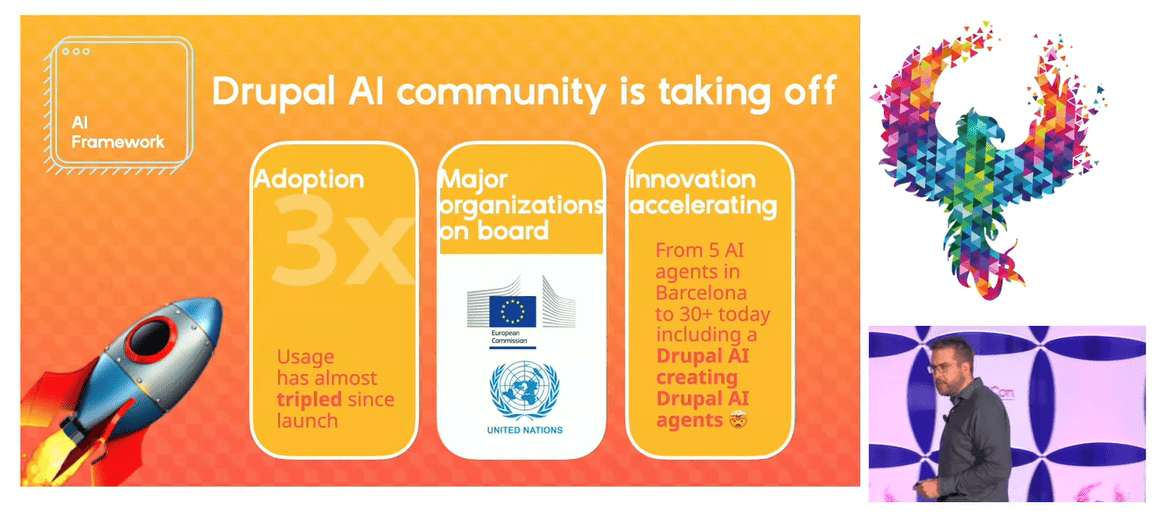
Drupal launches its AI Initiative
More exciting news has recently been announced by Drupal’s creator. Drupal has launched its AI Initiative with over $100,000 in funding and a dedicated team to accelerate AI development within the platform. The initiative introduces AI tools that help users create content, generate landing pages, and optimize performance based on clear goals and brand guidelines. Changes made by AI are always reviewable and controlled by the user.
AI creates design components for Experience Builder
“I think it’s just mind-blowing that you can literally take any image on the Internet and instantly turn it into an Experience Builder component,” said Dries Buytaert. Indeed, we saw the latest impressive demo of turning an image into an interface component on the fly. Read on to discover all the details.
Experience Builder — a cutting-edge tool for creating and styling pages in Drupal — is gearing up for its full launch. It is a key feature of Drupal CMS — a new version of Drupal designed to empower non-technical users with pre-configured tools and an incredibly intuitive interface. Check out our overview of Drupal CMS 1.0 and stay tuned for the release of Experience Builder in the upcoming Drupal CMS 2.0.
One of the hottest topics in the Drupal community right now is the integration of AI with Experience Builder. You tell AI what kind of interface component you need, and it generates one for you, making further improvements based on your feedback.
At Driesnote Atlanta, James Abrahams, AI track lead for Drupal CMS, showed how the new suite of AI agents created a component based on an image from Figma — a popular tool among designers for creating the look and feel of web page elements.
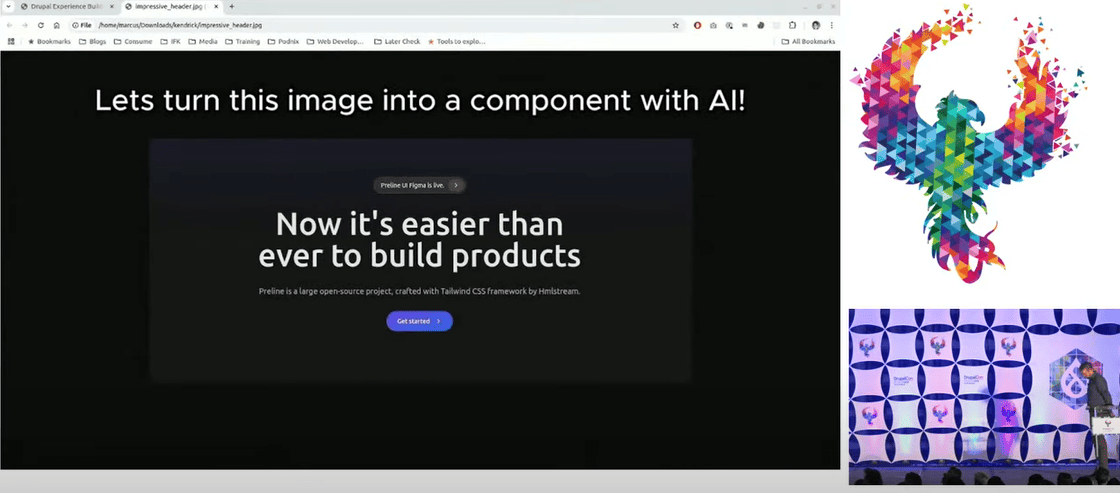
James uploaded a Figma image of a component — a block with text and a call-to-action button — to Drupal and asked AI to build it. No coding was needed; the component was created right before our eyes. James then compared the result to the original image and requested improvements to the colors, button shapes, and more. As AI made the adjustments, the changes were displayed in real time within Experience Builder’s new built-in code editor.
It’s incredibly convenient to see the immediate impact of code changes on the component — and if needed, you can easily undo anything the AI has done.
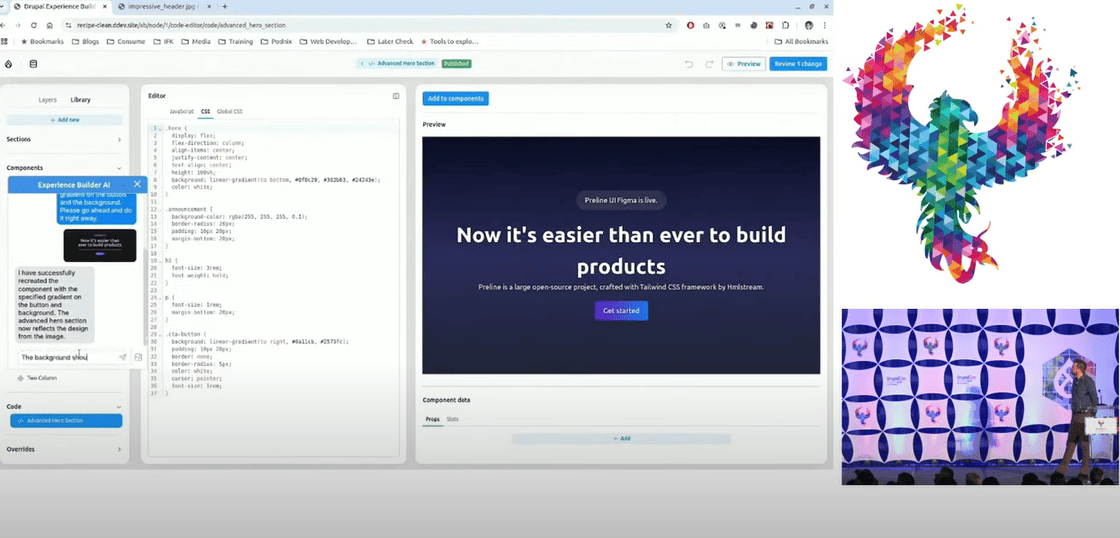
Soon, there might not even be a need to check the result or ask for improvements. James mentioned there is a new functionality coming. AI is going to build components, check them, compare them to the original images, and make adjustments on its own. Furthermore, James announced that work is underway to enable AI to make full-site migrations, including the data and the theme.
The AI module is gaining traction
The previously mentioned Drupal AI (Artificial Intelligence) module is evolving rapidly, thanks to the efforts of top AI experts in the Drupal community. Back in October 2024, it was still in its alpha stage — but now, not only has it reached an official release, development of version 2.0 is already underway.
The most exciting features of this mega module include (but are not limited to):
- Unified AI framework. You can use AI from OpenAI, Anthropic, Fireworks, Hugging Face, Mistral, Ollama, and many more — all from one flexible, vendor-agnostic module. However, you’ll also need a module for a specific provider, and there are plenty of them in the Drupal AI module’s ecosystem.
- Related modules for all kinds of tasks. In addition to various provider modules, there are useful modules designed to extend Drupal AI in specific ways.
- No-code power for site builders. Site builders can build AI-powered features with simple interfaces — no coding needed.
- Developer-friendly and extensible. Developers can swap providers easily, integrate local models, and set up automated ECA (Event-Condition-Action) workflows — ideal for custom AI tools.
- AI Explorer. This dedicated section in the admin interface is the perfect space to test out your prompts, explore how the AI responds, and get a feel for its capabilities.
- Smart content tools. Content editors can write, rewrite, translate, adjust tone, summarize, or check for moderation violations — all directly inside CKEditor.
- Validation. You can use AI to check if text or any other data entered in a field meets certain rules.
- AI Automators. The module enables you to automate tasks like filling in fields, pulling info from files or websites, or running AI prompts — all in flexible workflows.
- AI Assistants API and Chatbot framework. You can set up and control how AI chatbots work on your site.
- Multilingual support. The tool allows you to get one-click AI-powered translations.
- Logging. It’s possible to log all AI interactions.
AI enhances search on Drupal websites
One of the standout features of the AI module is better search functionality. The AI Search submodule upgrades traditional keyword-based search by adding semantic understanding — helping your site grasp what users mean, not just what they type. As explored by James Abraham in his video, this smarter approach can surface more relevant results even when search terms don’t directly match content.
For example, could someone find an article about “supercontinents” by searching for the phrase “Hollow theory”? Traditional search would likely fail, since that exact phrase doesn’t appear in the article. But with the Page Search Boost feature, it works — because AI uses two search indexes: one traditional and one semantic, powered by vector databases like Milvus or Pinecone.
This dual-index method improves result relevance while also reducing the possibility of AI hallucinations — situations where AI confidently makes things up that aren’t true. Users get smarter, more accurate search results without invented content.
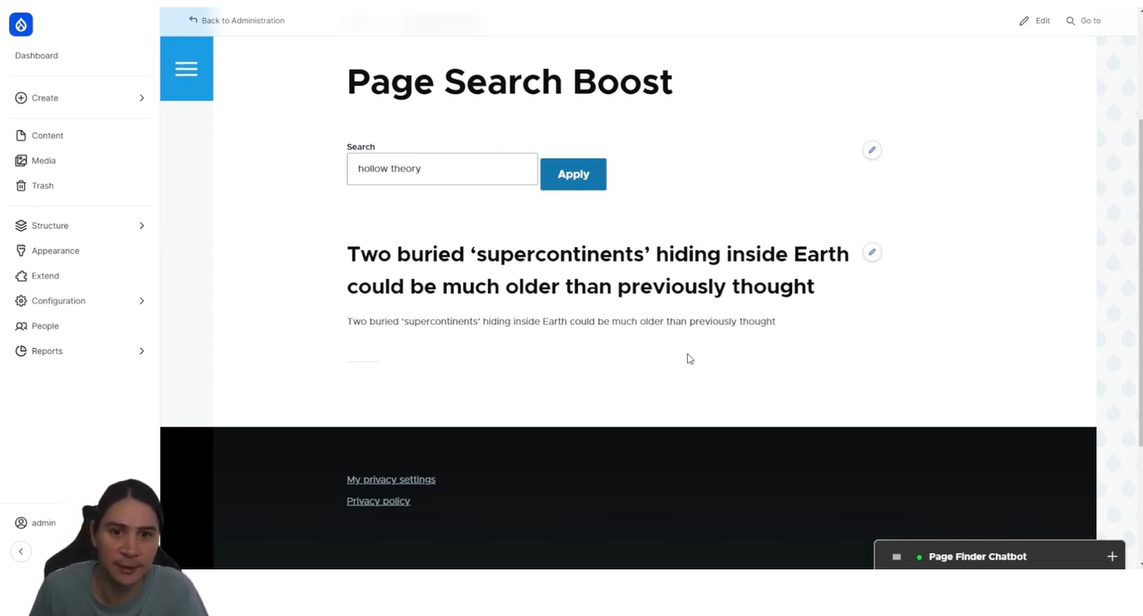
The AI Agents module has got you covered with agent creation
One of the great tools in the Drupal AI ecosystem is the AI Agents module. It has had a stable release in recent months and has been featured in the “Talking Drupal” podcast.
We’ve mentioned earlier the rapid growth in the number of AI agents for Drupal. However, you don’t have to go with the existing ones — and here is where the AI Agents module’s mission is fully implemented. The module is designed to simplify and streamline the creation of all kinds of AI agents.
This includes “text-to-action” agents that can create or modify content types, fields, taxonomies, and more — based on plain-text instructions. Just simple user’s words turn the Drupal wheels in motion with the help of AI.
The Anthropic Provider module brings a new AI tool — Claude
Anthropic Provider is a new and exciting Drupal module in the realm of artificial intelligence. It connects you to the AI tools by the Anthropic team. The flagship product that has been generating a lot of buzz lately is Claude — a family of advanced AI language models designed to assist with tasks like writing, coding, and data analysis.
Claude is comparable to OpenAI’s ChatGPT. It’s built with a focus on safety, reliability, understanding complex instructions, and reducing hallucinations in responses. Currently, Claude 3.7 Sonnet is the latest and the most intelligent AI model available.
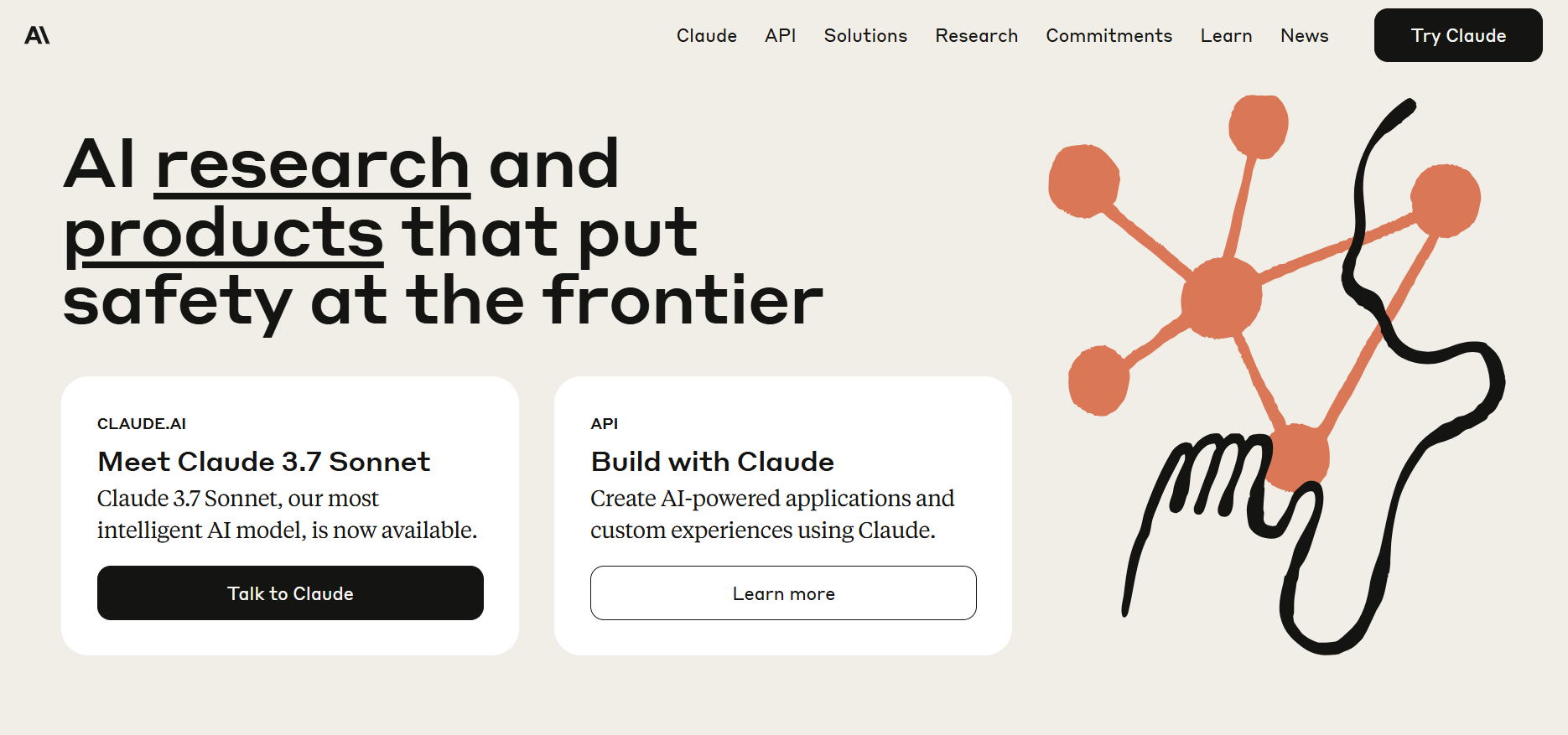
The Claude Code tool helps with real Drupal development
Claude Code is a specialized version of Anthropic’s Claude model that’s optimized for coding and software development tasks. Recently, Dries Buytaert dedicated a special video on how Claude Code can assist developers.
Dries asked Claude Code to build new features and modernize some of his code. Without writing a single line of code, Claude handled every detail from creating a custom Drush command to switching Drupal code from annotations to attributes.
AI helps you create Drupal modules
So can AI tools empower developers to create Drupal modules? Here is a fresh experiment by Jacob Rockowitz, a prominent Drupal contributor and the maintainer of the Webform module — one of the most installed Drupal modules of all time.
Jacob decided to harness AI to build a simple, useful module from scratch with the help of ChatGPT 4o. He chose to create a modern version of the Telephone filter module which had existed only for Drupal 7. This module’s job? To automatically detect US-based phone numbers in plain text and convert them into clickable links.
To guide the AI, Jacob wrote detailed prompts that clearly define the module’s purpose, coding standards, and specific filtering logic. The result was a functioning module built collaboratively between a senior developer and AI — a promising sign of how developers can pair human insight with machine efficiency.
Jacob estimates that the AI completed around 80% of the work. He then spent just 30 minutes reviewing and refining the output.
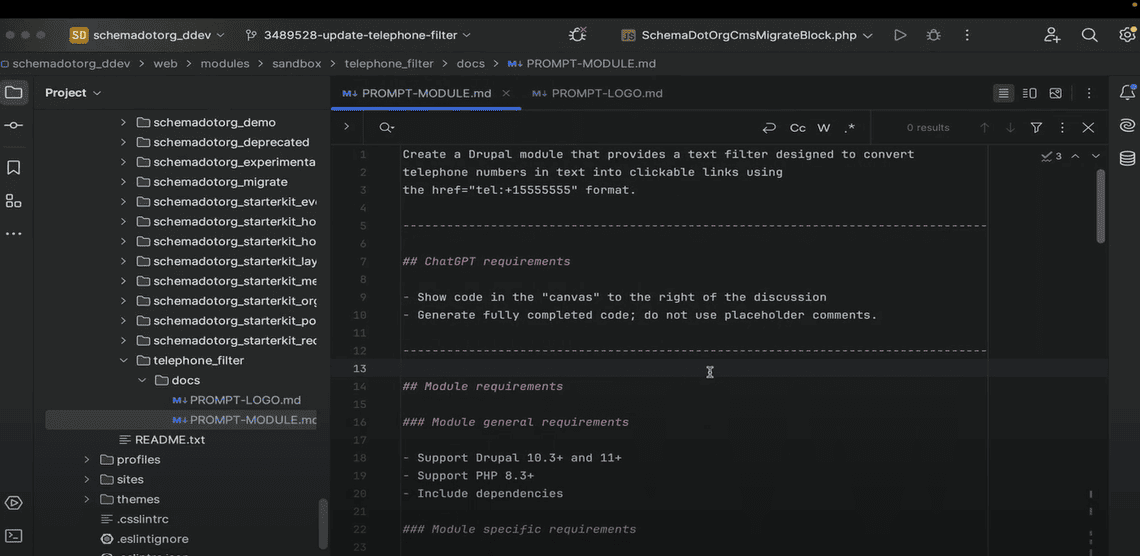
The thoughtful use of AI
When it comes to using AI, it’s easy to get carried away with its power, so we should never forget to approach it thoughtfully. At his DrupalCon Singapore session, James Abraham mentioned that one of the things the AI team wants to focus on is that they are NOT going to replace developers, content creators, or designers. The goal is to make AI support humans who are already doing things and help them do these things better.
James explained that no matter how intelligent AI becomes, you don’t simply hand everything over to it. He compared it to the real world: just because someone scores high on an IQ test, you wouldn’t give them unrestricted access to your data and let them do whatever they want.
That’s why transparency in how AI operates within Drupal — making it clear what’s happening behind the scenes — is so important. This echoes Dries’ emphasis on responsible AI principles, including the key idea of always keeping “a human in the loop.”
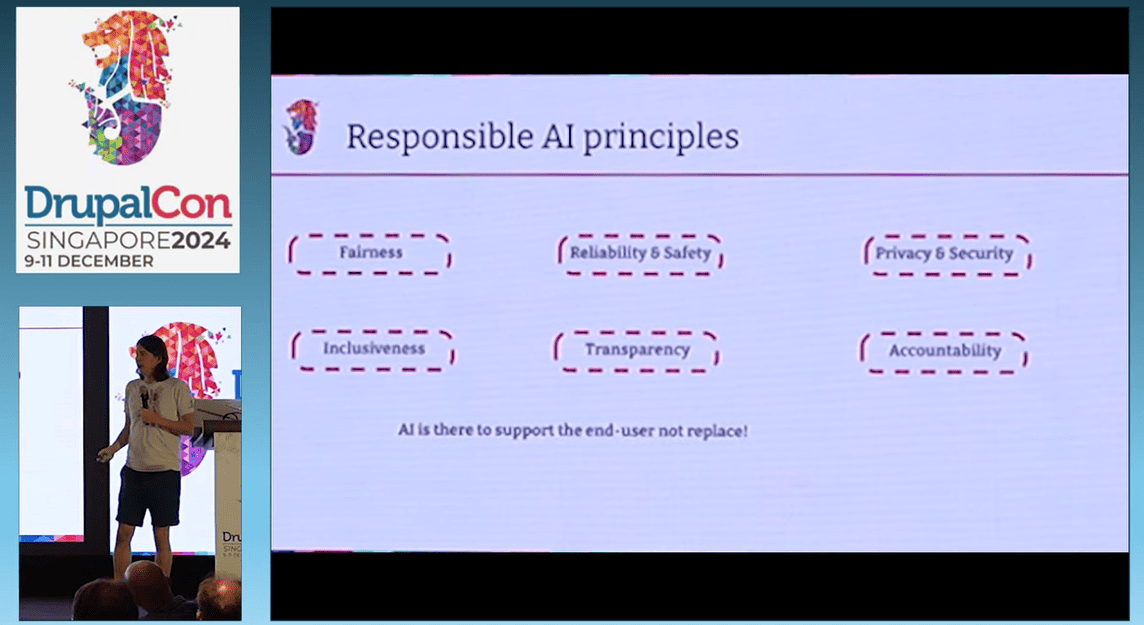
Final thoughts
There’s never been a better time to explore the possibilities of AI in Drupal — to be amazed, to question, and ultimately to embrace it as the new reality where anything is possible! With tools like the unified AI module, cutting-edge providers such as Anthropic, innovative features like AI Agents and semantic search, Drupal is leading the way in ethical, flexible, and modern AI integration. The future is bright — and it’s only just beginning!








